Recently sold on the website Only Used Tesla is what is believed to be the highest-mileage Tesla Model X in the world—a 2016 “90D” rental car/shuttle with over 400,000 miles on the odometer. The company that owned it, Tesloop, gave me the vehicle’s full maintenance records, so let’s look at every part that had to be swapped for this electric crossover to reach 400,000 miles in this condition.
Tesloop is a company that sells a “regional EV mobility network,” meaning it offers rides in Teslas between the cities of Los Angeles, San Diego, Palm Springs, and Las Vegas. With its Fremont, California-built cars regularly making those trips, Tesloop is known to have many of the highest-mileage Teslas on earth, and the company also has a reputation for keeping meticulous service records. That’s why I reached out to founder and chief evangelist Haydn Sonnad to discuss what had to be replaced to get this Falcon Wing door-having Tesla SUV to the big 400.
He sent me the machine’s full service records, arranged in reverse chronological order. I’ve pasted them below, underlining some of the replacement items that I find interesting. (Note that the “cost” column sometimes includes expenses not shown in the description column.) Below the records, I discuss the repairs in a bit more detail, drawing from the invoices and from Sonnad’s experience with this car and other Teslas.
Before we go on, I want to make clear that this story is not a criticism of Tesla, nor is it implying that its cars are less-than-reliable, or that they’re significantly more reliable or easier to maintain than most other vehicles on the road. There isn’t enough info here to draw those conclusions (consider reading Consumer Reports if you’re after that). The article is simply providing a close look at what it took to keep this particular EV on the road and in good condition for over three years and 400,000 miles. It’s fascinating stuff. And yes, there are a decent number of line-items, but I think we’re all well aware of the copious maintenance issues associated with some internal combustion engine cars, so just imagine how long this log would be on, say, a 400,000 mile Mini.
Anyway, here’s the full maintenance log:


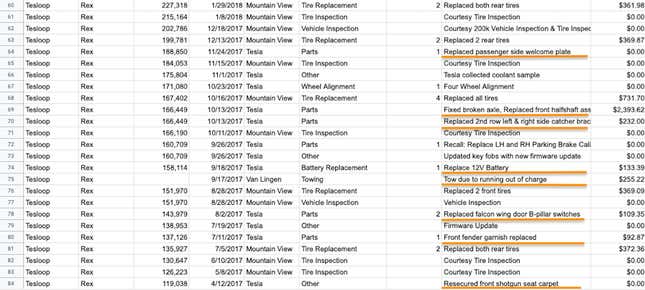

Let’s break the ~$29,000 worth of maintenance into categories: electrical; battery-related items; interior and exterior trim; seating; and drivetrain and brakes. We can start by looking at some electrical faults.
Electrical Failures
You’ll notice on the spreadsheet that, at 72,384 miles and 115,362 miles, the air conditioning compressor had to be replaced. “AC compressors are one that...we realized early on, was that they are not designed to be used around the clock,” Sonnad told me, pointing out that this Model X’s AC was in use pretty much all the time, as the car was driving through the desert.
He said that, in his experience, the compressors—which, it’s worth noting, are driven by the high-voltage battery, and not off an accessory belt like on an internal combustion engine car (see the one for sale on eBay below)—tend to have between 100,000 and 150,000 miles of lifespan. A cursory glance at online comments from Tesla owners shows that AC compressors seem to be a relatively common failure on the vehicles (and of course, to be fair, compressors fail on ICE cars, too).

At roughly 144,000 miles, the Falcon Wing door B-pillar switches were replaced for around $109. This door-opening/closing button is a known issue on early Model Xs, and the design was actually changed on later models.
“When the Model X first came out they had a little switch...it was a pretty crappy part and then they redesigned it...towards late 2017 I believe,” Sonnad told me. The part, shown below, required you to put your finger under a silver lever and pull it. “It would, after enough time, just pop out and break,” he said.
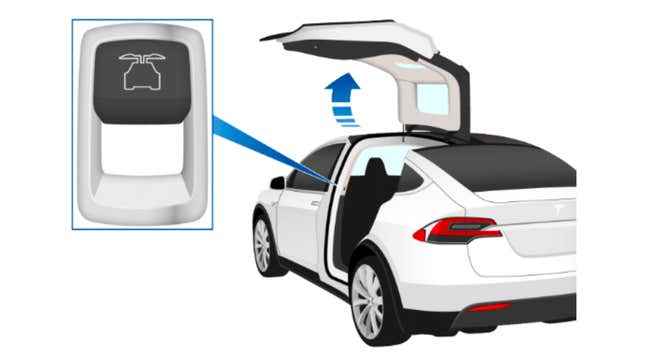
Other electrical issues that popped up over the years include the Media Control Unit, or MCU (that’s the big touchscreen in the middle of the dash) going blank. “Those have a few issues. One was the yellowing, which it has right now on the [replacement] one, which is unfortunate,” Sonnad said.

Those going blank and yellowing are not uncommon failures on older Model S and X models, I’m told. The replacement happened on this particular X at about 374,000 miles after the screen went blank, and it resulted in a fairly hefty bill of nearly $2,400:
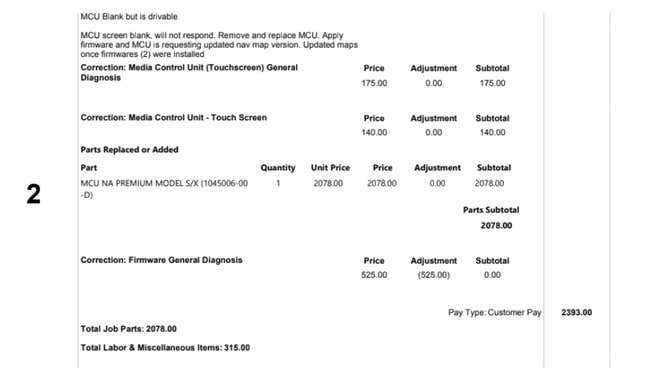
In addition, the airbag light came on at ~374,000 miles. The service center said it found a bad wire in the front seat belt buckle, and mended that for $111.25. Also, in case you’re curious, the car’s 12-volt battery had to be swapped three times over the 400,000 mile span.
Plus, the steering wheel switch (shown below) was replaced at ~236,000 miles. That’s the “left side scroll wheel,” according to Sonnad. He said it’s a relatively common failure. “They would like, pop in, and get dislodged inside the wheel, or just not function anymore,” he told me.
The trunk also wouldn’t open all the way, as indicated by the “Performed calibration on trunk to get it to open up all the way” line item at 302,000 miles (this service was apparently free of charge). “I’ve seen that a couple times with the cars,” Sonnad told me. “The sensors are a little bit fickle.” Sometimes they recalibrate themselves, he said, telling me the Falcon Wings and the trunk not opening all the way “is a somewhat regular occurrence.”
Battery/Charging Failures
There were some issues with the battery and charging system. The high voltage battery itself lasted all the way up to 317,000 miles, but was traded for a fresh one after users found themselves running out of charge despite a nonzero indicated range, hence the line item “Vehicle died with 56 miles.”
“This is a recurring issue with high mileage Model Xs and Model Ss,” Sonnad said, “which is that they would die when they still display range. This is between 0 miles and I think 60 was the highest we ever saw, where it would say ‘hey, you have 60 miles left,’ and it would just die.” Sonnad says Tesla’s warranty technically shouldn’t cover such battery degradation, but he told me his team was able to convince the company that what was happening was essentially a failure, because having a range that’s not accurate severely hinders the car’s usability.
“We’ve used that justification for warranty on all of the cars that we’ve had high voltage [batteries] replaced,” he told me, saying his understanding is that this inaccurate range readout has been fixed on more recent Model 3s.
It’s worth mentioning that Tesla says its battery warranty is “8 years or 150,000 miles, whichever comes first, with minimum 70% retention of Battery capacity over the warranty period.” Per Electrek, this is a recently-revised warranty, with the EV-focused news site say that, previously, the battery was guaranteed for an infinite number of miles, and battery degradation was not covered.
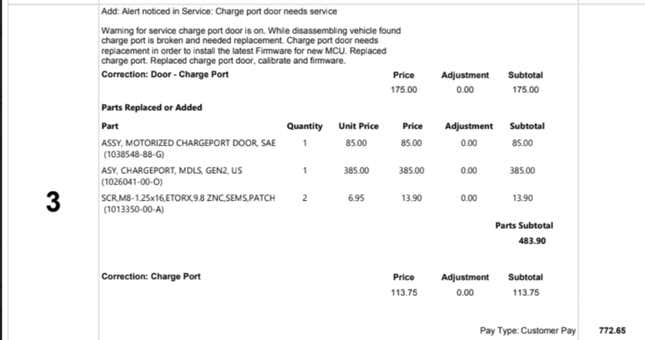
Charge port doors have also been an issue, per the ~288,000 mile service called “Adjusted charge port door to sit flush with the body” and the “Charge port Door replacement” at ~374,000 miles. This latter service actually included replacing the charge port itself (which, per the invoice above, was broken) in addition to replacing the door, a job that, according to the invoice, was necessary to install firmware for the new MCU.
“Charge port doors have a lot of issues,” Sonnad told me. “We’ve had a lot of replacements on those. I think almost every car has gone through at least like, two,” going on to say that the main issue is that people manually close the doors. “They break because, I guess, they’re not designed to be manually pushed around,” he opined. The actual charge ports also tend to have problems, he says, though sometimes they can be recalibrated.
Interior and Exterior Trim
At 119,038, you’ll see “resecured drivers side falcon wing door trim” and “resecured front shotgun seat carpet.” Sonnad told me this kind of thing is pretty normal in the Teslas he’s had experience with. “Pretty frequently, there will just be minor trim issues,” he said, saying plastic trim will fall loose, but that Tesla usually takes care of it free of charge. “90 percent of the time, that’s goodwill by Tesla,” he told me.
Speaking of trim, the maintenance records show wheel or fender “garnish” having to be replaced quite frequently—at around 137,000 miles, 235,000 miles, and 317,000 miles. This is the thin, semicircular plastic fender flare pointed out below:
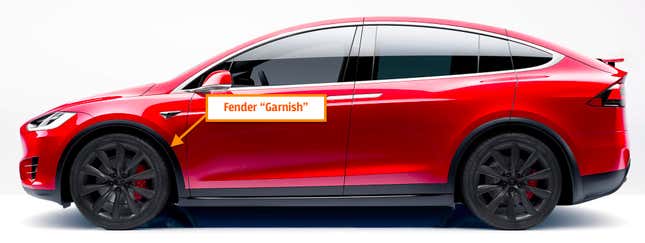
“[The fender garnish] will just come loose after enough dirt kicks it,” Sonnad said, admitting that he’s not exactly sure why this Model X had them replaced, but he thinks perhaps they fell off or broke.
He expounded a bit on Tesla exterior trim problems in general, pointing out a particularly interesting cause of failure. “Parts of the trim would come loose due to driving through water at medium to high speeds,” he told me. “Especially with the Model S—so some of these could be water related. On this car, I don’t think any of them are.” (It’s worth pointing to our story about a Tesla Model 3's bumper falling off because of rain).
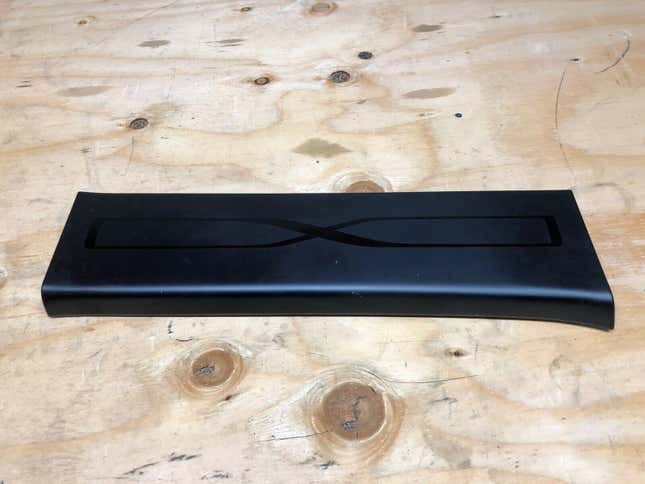
The spreadsheet mentions other trim pieces needing mending. The passenger’s Welcome Plate—the plastic thing inboard of the base of the door jamb (see above)—got swapped at ~189,000 miles, and the center console sliding door clip that keeps the lid from sliding when it’s open had to be re-secured at around 236k. Plus, at ~288,000 miles, the “bracket inserts” for the glovebox had to be taken care of after the lid started coming unhinged when open and becoming difficult to close.
I don’t know the exact nature of the repair, or what “bracket inserts” are, but I did find a similar-appearing issue on YouTube (see above) that resulted from broken plastic hinges.
Other trim-related items include, at 317,000 miles, something labeled “Primary seal FR LH -MX.” That, per Sonnad, is a door seal that was apparently deteriorating. Also mentioned at 302,000 miles is an issue where the HVAC vent on the driver’s side second row was providing poor airflow. To mend this, technicians readjusted some ducting that they’d found twisted.
Seating Failures

There’s a $232 line item in Tesloop’s spreadsheet labeled “Replaced 2nd row left & right side catcher bracket.” That, according to the diagram above that I found on Russian Tesla parts website Electromobili, appears to be some sort of flat bracket that I assume mounts to the floor. The service record states that the fix was meant to addressed the concern: “2nd row seat are noisy when adjusting.”
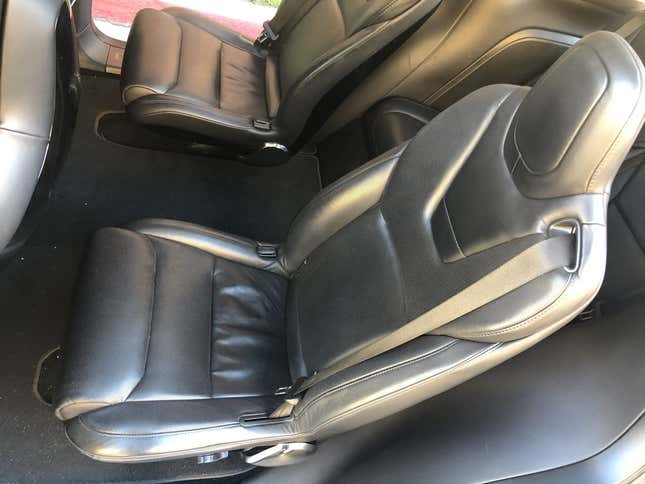
That’s not all. There’s also a hefty $5,000+ bill at 236,000 miles labeled “Replaced both middle row seats.” Apparently, mechanisms that allow the seats to slide fore-aft and lean forward and backward can be a problem on Teslas, though Sonnad said the tilt issue is the worse of the two. “We’ve had a few different seat issues,” he told me. “The mechanical parts below them... from moving them back and forth and leaning them...when you would do that sort of motion, it started to get really bad,” he said, saying the mechanisms made a cracking noise, and that this was also a problem on the Model S. “The newer cars, we have not had that issue,” he told me.
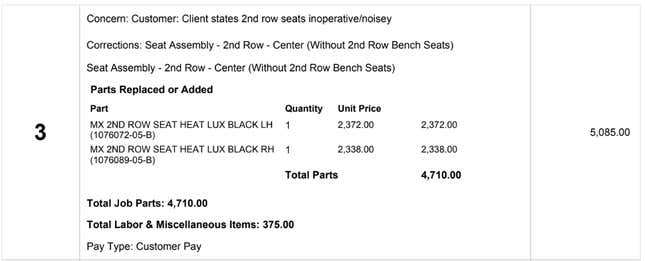
Other Tesla owners have taken to the interwebs to complain about such seat noises, so apparently this is not an uncommon problem.
Drivetrain and Brakes
What I find cool is the fact that it appears that the first time this Model X’s brake pads and rotors were replaced was at 166,000 miles. Compared to an ICE car, that seems like a lot of miles, even if much of the Tesla’s driving was on the highway. You can thank regenerative braking for this—instead of brake pads slowing the vehicle down through friction, it’s the motors acting as generators that steal the Tesla’s kinetic energy.
“If you’re running...standard regen on highway driving, [brakes] can last a long time...and we would train drivers to do as little braking as possible,” Sonnad told me. “I think we had a car on its original brakes at like 300 [thousand miles] or something.” Aside from the front pad/rotor change at 166,000 miles, the spreadsheet shows a brake check at 288,000 miles (the pads had 5 mm left, per the document), and then all four pads and rotors got swapped at 389,000 miles.
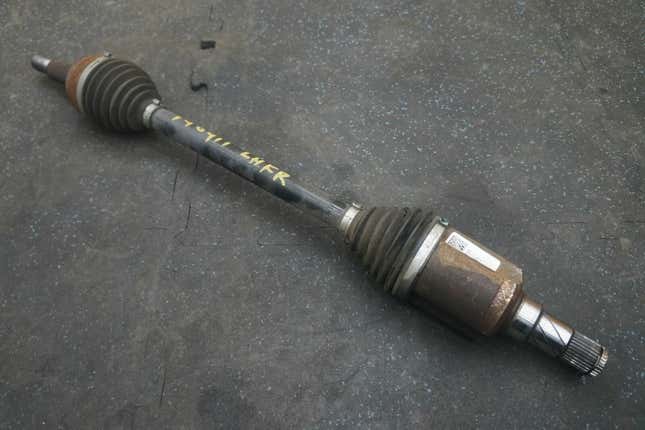
In addition to the brake job, the 166,000 mile marker also gifted the Model X a new axle (above is an image of one for sale by Pacific Motors) and rear left wheel bearing. The bearing isn’t surprising (those wear out on all cars), though the “broken axle” sort of is. I asked Sonnad about it, and he told me he can’t remember what happened.
“I don’t recall there ever being any incidents where suspension parts were broken during operation, requiring the car to be towed for replacement,” he told me. “It was always, I believe, drivable,” he continued, saying he assumes this “broken axle” wasn’t catastrophic, but rather in the category of minor damage that still required replacement.
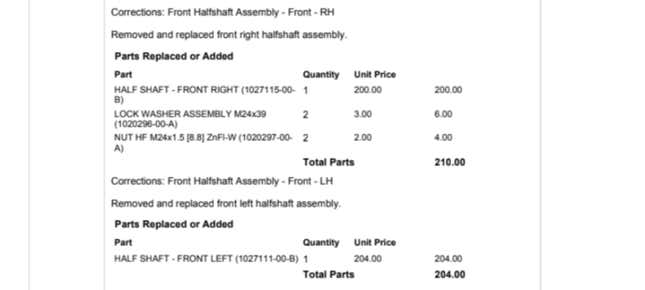
Looking at the invoice, it appears that technicians replaced both the left and right halfshafts. Along with the front brake pads and rotors, as well as the wheel bearing, the total for the job came to nearly $2,400.
According to the invoice, the job was a response to a complaint about a vibration while driving. A quick internet search reveals that shudders resulting from half-shaft issues are relatively common on Teslas, though they usually happen under acceleration and when the vehicle’s ride height is adjusted to a high setting (since that increases the axle’s CV joint angle), as pointed out in a Reddit thread on the topic. I’ll quote the user Derfein, who discusses the problem:
This is a well-known issue among Model X owners. To be more precise, it’s not the half-shaft per se, but the CV joint at the end of the half-shaft...At oblique angles (imagine turning a doorknob with your elbow at a high angle) the CV joint can’t keep up and starts to “shudder”, wearing out over time. They replace the whole stump unit when it’s worn out.
You can research the issue and all that, but in a nutshell the drive geometry angle in the Model X is not designed so well. To reduce the obliqueness of the angle between the shaft and the CV joint the remedy is to set the suspension lower, effectively lining up the drive shaft at a less oblique angle to the CV joint.
Other drivetrain fixes included the change of a front axle seal at over 300,000 miles, and—and this is a big one—replacing the drive unit at 308,000. “They normally last a descent amount of time...over 200, 250,” Sonnad told me. “They’ll start with this whirring sound [when you accelerate] and it gets worse and worse and worse.” Luckily, this was, according to the record, fixed for free. Even if it hadn’t been, 308,000 miles is a lot.
What’s The Takeaway?
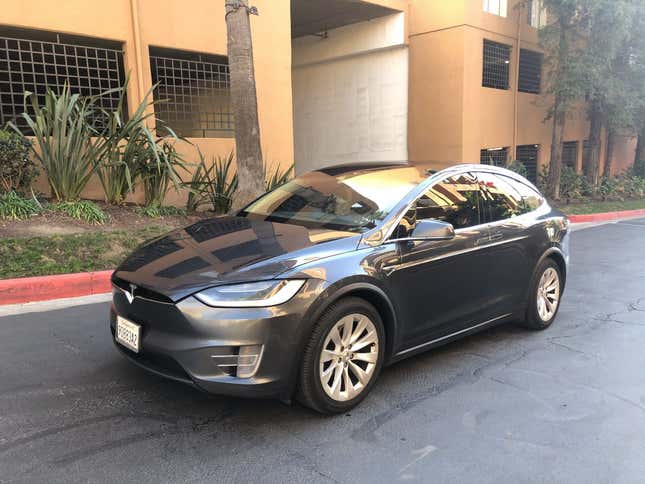
While showing a single service record without contextualizing it against a number of other automobiles limits its value as a comparison tool, the maintenance record is interesting in that it gives some level of insight into how electric cars fail. In many ways, they share failure modes/maintenance requirements with ICE cars—electric switches go bad, trim falls apart, motors crap out after lots of miles, tires need to be replaced, and alignment needs to be adjusted. In other ways, EV maintenance is different; the brakes hold up for a really long time, the battery can fail in a strange way that makes occupants think there’s range left when there isn’t (ICE cars’ fuel gauges fail, too, it’s worth noting), and the port through which you feed energy into the car can be wonky.
It’s also interesting to learn about some of the Tesla-specific issues, like the glovebox hinge that apparently fails at a decent rate, the electric scroll button that falls into the steering wheel, the CV axles that shudder when the car sits at high ride heights, and the seat structures that make noises. That last one is especially odd, I find.
Sonnad did have something to say about his overall experience with this Model X. “The big takeaway is that, on a per-mile [basis], maintenance is relatively cheap,” he told me, saying it’s comparable to a Prius, and noting that many of the Model X’s costs came at the end of its life.
“The first like 200,000 were super low cost,” he said, but things went up dramatically from there. “The big key win is...there was way less maintenance needed than I think an ICE car would have had...the frequency is lower,” he claimed.
He mentioned that he thought Tesla’s service was a bit expensive, and not always a great experience. “Dealing with Tesla is really hit or miss,” he started. “It’s super dependent on the actual people at the service center, and how the manager is.” He said he had to sometimes have a back-and-forth to push service centers to agree to fix his car. “We had to push them and push them and push them to do things. They weren’t super proactive about it,” he told me. He also mentioned that service could take a while, which was especially suboptimal for his business, which puts the cars to use around the clock.
Still, he said, “Overall, Tesla’s attitude was good.”
A Closer Look At The 400,000 Mile Model X
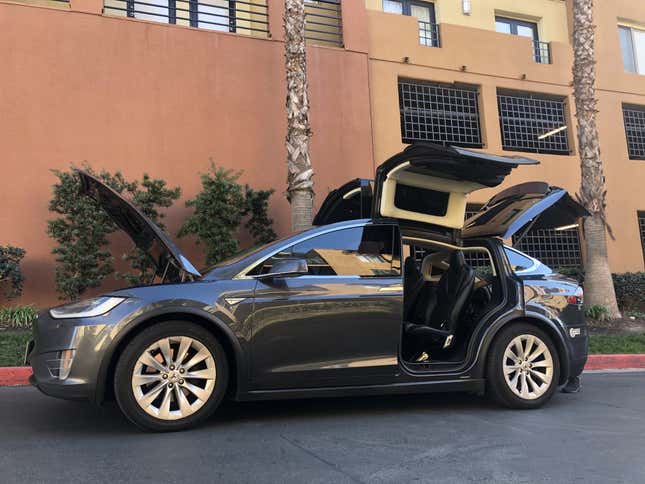
The car, which recently sold for $30,000—a price below the asking price that Tesloop claimed was already the lowest on the market—appears to be in very nice condition inside and out. The company attributes that to the fact that Tesloop made sure the car was “cleaned almost every day and has always had mechanical issues attended to asap.”
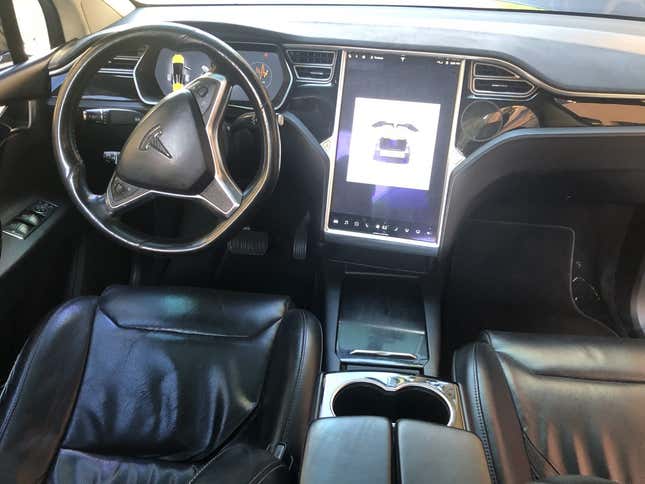
But the Model X, which Tesloop has named “Rex,” does have a few dents and scratches, as well as some wear on the driver’s seat and some problems with the driver’s door, whose mechanism “will likely need to be replaced in the near future.”
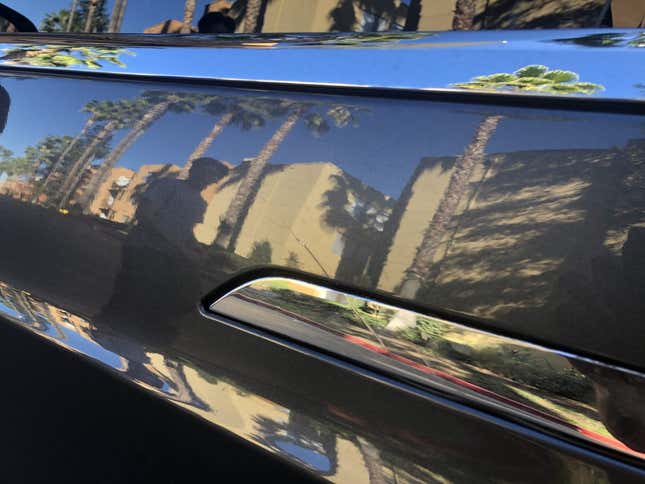
Plus there’s a “Slight ‘whirring’ sound when accelerating between 25-40 mph,” which Tesloop says could be an issue with the motor that would be covered by the car’s warranty.
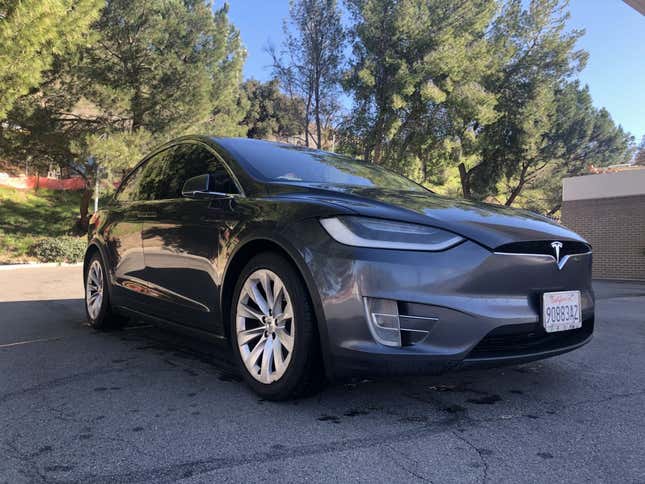
With a recently replaced high-voltage battery (which charges to 229 miles of range at 100 percent, Tesloop claimed in its ad. From the factory, it was rated at 257 miles.) and rear drive unit, this seems like it might actually have been a decent buy for someone looking for a relatively dirt cheap Model X.
Update Feb 21, 2020 3:46 P.M. ET: Since a number of folks were wondering, the sum of all the maintenance costs logged in the spreadsheet over ~40 months comes to around $29,000.
Update Feb 24, 2020 9:20 A.M. ET: The sale is still pending, Sonnad said Saturday. The car was last listed for $32,000.